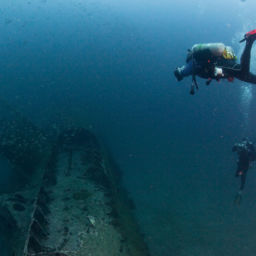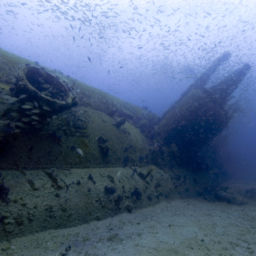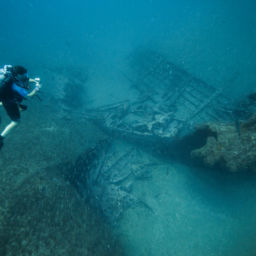From January to the end of August 1942, German U-boats attacked more than 285 vessels in North American waters. Just off coastal North Carolina, the remnants of many of these ships lie on the ocean floor. The remains of this little-known battlefield serve as the final resting place for 90 ships and nearly 1,700 men lost during the Battle of the Atlantic. Over the course of the battle, eight Allied convoy vessels, 78 merchant freighters and tankers and four German U-boats sank off North Carolina’s coast. Each shipwreck tells a unique story; today we visit the HMT Bedfordshire.
HMT Bedfordshire sinks
The British HMT (His Majesty’s Trawler) Bedfordshire began life in 1935 as a deep-sea fishing trawler for the Arctic. The Royal Navy bought the vessel in October 1939 and converted it for military service as World War II began. After becoming a well-seasoned patrol vessel, the HMT Bedfordshire, along with 23 other ships, began service in U.S. waters. On February 15, 1942, the ships set sail, arriving at the U.S. Naval Yard in Brooklyn, New York. While en route to the U.S., HMT Bedfordshire picked up survivors from the Norwegian merchant ship Tyr, sunk by U-196.
By late March, HMT Bedfordshire began operating off the North Carolina coast, participating in critical convoy duty. On May 7, 1942, it made its last refill stop at Morehead City, North Carolina. It returned to patrol three days later. On May 10, it rendezvoused with another British escort, HMT St. Zeno, off Cape Lookout, to support a small convoy of merchant vessels making their way toward Hatteras. After successfully escorting the ships, HMT Bedfordshire began patrols again, working southwesterly toward Morehead City.
The evening of May 11, U-558 was patrolling the waters off North Carolina’s coast. A little after 10 pm, it spotted the silhouette of a small lone vessel, HMT Bedfordshire. U-558 followed the boat closely for an hour and finally fired two torpedoes, but neither struck HMT Bedfordshire. U-558’s captain decided to attack again and sent a third torpedo. This one caught the trawler directly amidships along the port side. The ship sank so suddenly that it was unable to make a distress call. Three days passed before anyone realized that HMT Bedfordshire was lost.
Laid to rest
Two coastguardsmen from Ocracoke coastguard station set out along the beach for a routine patrol the morning of May 14. Driving their jeep along the sands, they thought they spotted a swimmer, but instead they found a body. A local fisherman later found a second body. Aycock Brown, a special investigator from the Office of Naval Intelligence, came to Ocracoke to identify the sailors.
The two men, sub-lieutenant Thomas Cunningham and ordinary telegraphist Stanley Craig, were laid to rest in plots next to each other in the local cemetery. About a week later, two more sailors also presumed to be from HMT Bedfordshire were found and buried alongside their shipmates. Other bodies were located from the surrounding waters, but were buried elsewhere.
In 1976, as part of the state’s bicentennial celebration, the site where the four sailors are buried was leased in perpetuity to the Commonwealth War Graves Commission. Although it remains British property, the U.S. Coast Guard cares for the cemetery. The agency conducts a yearly ceremony to honor those who gave their lives defending our country.
Diving HMT Bedfordshire
HMT Bedfordshire rests in 105 feet (32 m) of water, off Cape Lookout, North Carolina. For the average diver, the conditions are more stable. The inviting Gulf Stream waters makes it a favorite dive for many. Divers visiting the wreck must take heed of unexploded ordinance when visiting the site.
HMT Bedfordshire lies in two sections resting about 80 feet (25 m) apart. The ship most likely broke into multiple sections when U-558’s torpedo tore into it. However, there is evidence of possible demolition. Allied patrol craft picking up the wreck as an unidentified sonar contact may have dropped depth charges or bombs on the site.
Divers will note that the main section of the wreck is much larger and better defined than the bow piece. At about 145 feet (44 m) long, the section extends from where the bow is broken off to the stern. The steel-hulled vessel has little relief beyond sections of I-beams, hull plates, pipes, machinery, and bulkheads. Sand almost entirely covers the foremost part of this section with the exception of the port side. This area retains vertical portions of hull and frames that protrude through the sand.
About 30 feet (9 m) aft of the hull break, the ship’s boiler sits along the centerline of the wreckage. The single boiler, including a portion of the cylindrical uptake, provides the highest relief on the site at about six feet (2 m). From the boiler toward the stern, much more wreckage remains above the sand and is more distinguishable.
As divers move aft along the site, they will see portions of the reinforced boiler room’s walls. Divers will also see some of the original deck plating, vertical sections of the outer hull, deck-support stanchions, and various other disarticulated constructional elements. Among the wreckage, parts of the main trawl winch are still visible, denoting the vessel’s history as a fishing trawler. Aft of the trawl winch at the very stern of the wreck are remnants of naval fittings and explosives that indicate the vessel’s use as a military vessel when lost. These components include portions of the vessel’s depth-charge rack, depth-charge supports, and multiple unexploded depth charges.
“I cannot describe fully the feeling of reverence I had when I first saw the remains of the vessel,” says Will Sassorossi, maritime archaeologist for Monitor National Marine Sanctuary.
“To know that all 37 crew members died on board that night made me more conscious and respectful in exploring the site.”
In describing his first dive on the site, Sassorossi says, “I remember sitting on the deck of our dive boat rather quiet, as I wanted to fully take in what I had just completed. It is hard to describe this feeling, but ultimately I wanted to make sure that those who were lost here were never forgotten.”
As with other World War II shipwrecks, HMT Bedfordshire is a war grave with the loss of the entire 37-member crew. Visitors should not disturb the site, leaving the wreck and its artifacts in place for future generations. In July 2015, NOAA’s Office of National Marine Sanctuaries nominated HMT Bedfordshire for the National Register of Historic Places, and the nomination succeeded. In addition, on January 7, 2016, NOAA entered into a Memorandum of Agreement with the Royal Navy of the United Kingdom for the research, management, and in situ preservation of HMT Bedfordshire.
To learn more about HMT Bedfordshire and other World War II shipwrecks off the North Carolina coast, click here.
An Expanded Sanctuary
In an effort to honor the service and sacrifice of those lost during the Battle of the Atlantic, NOAA in 2019 will release a draft proposal to expand the boundaries of Monitor National Marine Sanctuary. The proposal will include a nationally significant collection of shipwrecks that currently have little or no legal protection. The expansion would also establish the largest area designated as a World War II battlefield anywhere in the world. The proposal includes HMT Bedfordshire.
To learn more about the proposal, click here.





















